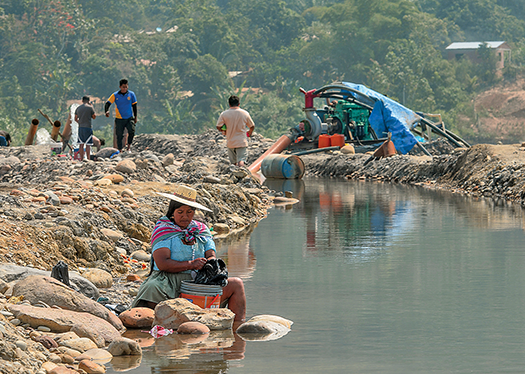
Small-scale gold mining is the principal worldwide source of mercury pollution. (Photo by Rodrigo Urzagasti)
The economic interests of Bolivia’s mining industry have frequently run counter to environmental and public health considerations. But the problem has come into unusually vivid focus in recent weeks, starting with an Oct. 17 presentation in the national capital of La Paz by the United Nations special rapporteur on toxic substances and human rights.
Special Rapporteur Marcos Orellana appeared at a La Paz seminar to discuss a report he authored on the dangers posed to the environment and human health by mercury that is used in small-scale gold mining. (See "Call for ban on mercury use in small-scale mining" —EcoAméricas, October 2022.)
This mining, in which mercury is used to separate gold from sand or ore, constitutes the “principal source of mercury pollution worldwide,” he said. The report, which Orellana delivered to the U.N. Human Rights Council on Sept. 20, urges a global ban on mercury in small-scale mining.
On the day of Orellana’s La Paz presentation, the Bolivian President Luis Arce’s administration launched a Toxicology Network of medical specialists to monitor and help manage mercury-exposure risks in Bolivia, where small-scale gold mining, much of it illegal, abounds.
The government also presented a National Plan of Mercury and Health to guide diagnosis, treatment and monitoring of those exposed to mercury in their work as well as those exposed indirectly—for instance, as the result of regular consumption of mercury-tainted fish.
Alfredo Laime, head of the country’s National Environmental Health Program says the existing public-health information network reports no current cases of mercury poisoning in the country. But he adds: “We know there are people who are exposed to mercury because they eat fish in gold-bearing areas where methylmercury accumulates in fish, and it is necessary to be prepared to carry out epidemiological surveillance.”
Oscar Campanini, director of the Center for Bolivian Documentation and Information (Cedib), a respected nonprofit social and environmental research center, says ever more mercury is being brought into the country. He cites Cedib reports showing that as of 2014, Bolivia was importing some 10 tons of mercury annually, but that over the past seven years these imports have shot up to 192 tons annually.
Campanini points out that mining industry figures show 60 to 90 tons of mercury is used in legal Bolivian gold mining. “It is assumed that the amount beyond that goes to illegal mining or is sold on the black market to neighboring countries.”
Miners on march
A week after Orellana’s presentation, downtown La Paz was paralyzed by members of mining cooperatives protesting a government plan to raise the tax on exports of artisanally mined gold to 5% from the current 2.5%. The cooperatives also demanded updated contracts allowing them to exploit protected areas in which mining activity existed before the government had earmarked the land for conservation—even if the activity runs counter to local indigenous people’s rights and wishes.
Within 72 hours, the government and the cooperatives agreed on an increase of the export tax for artisanally mined gold to 4.8% rather than the 5% originally announced. Congress still must approve the new figure, which although higher than the current one, would fall well short of the 15.5% that applies to industrially mined minerals.
Mining cooperatives pay lower taxes than industrial mining companies because they are considered artisanal operations that provide subsistence income for families. But critics say mining companies have illegally partnered with these cooperatives to take advantage of the latter’s lower export-tax rate, providing capital, equipment and dramatically greater scale to ostensibly artisanal operations. It is therefore no coincidence, these critics say, that mining cooperatives in 2021 accounted for 94% of Bolivian gold production and exports.
“Without doubt, the demonstration and negotiation was evidence of the social and political power of the gold-mining cooperatives,” Campanini says. “The increase [of the gold-export tax on cooperatives] to 4.8% is a lot less than would be appropriate for this portion of Bolivia’s mining sector, and it’s less than what even the government expected. Yet the government’s need for more tax revenues prompted it to accede.”
The government’s agreement with the cooperatives also called for updating protected-areas management plans to allow 93 mining sites in three conservation areas—12 in Madidi National Park, 13 in Cotapata National Park and 68 in Apolobamba Natural Area.
Not well received
News of the accord prompted a storm of criticism from green advocates, academics, indigenous groups and opposition politicians who argued the deal would ensure the continuation of destructive economic activity on lands ostensibly earmarked for conservation. Many of these critics have charged that Bolivia’s National Protected Areas Service (Sernap), the lead government agency overseeing protected lands, is doing the bidding of mining cooperatives and others extracting natural resources. (See "Illegal gold mining in Madidi Park fuels protest in Bolivia" —EcoAméricas, February 2022 and "Bolivia’s Alipaz sees government complicity in illegal gold mining" —EcoAméricas, April 2022.)
The furor prompted the government to strike a new deal with mining cooperatives. Signed Nov. 7, the updated accord preserves the first’s increase of the export tax on cooperative-mined gold to 4.8% rather than the originally recommended 5.0%. But the highly controversial protected-areas mining provisions were not included in the new agreement.
While their absence marked a retreat by the government and the cooperatives, green advocates say the new accord leaves questions about permitting, enforcement and land-use in protected areas unresolved. They say events of recent weeks only underscore the political difficulty of curbing environmentally damaging extractive economic activity. Says Campanini: “It’s pretty clear that the principal concern of the government and the central interest of the mining cooperatives is not public health or the environment but, rather, royalties.”
- Javier Lyonnet
In the index: Woods are felled and riverbanks shredded in the quest to find these flakes. (Photo by Rodrigo Urzagasti)